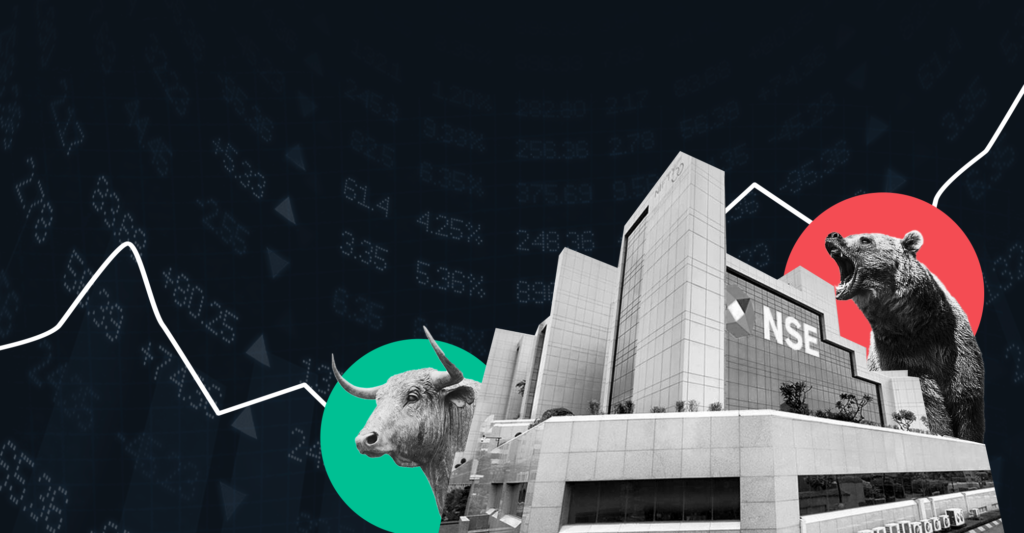Last Updated on Aug 18, 2021 by Kushal Dudheria
The equity market is a lot about timing. If you make the right choices and play by the right strategies, you may be presented with lucrative opportunities to generate wealth over time. One of the most popular approaches that investors are presented within the equity market is the choice between trading and investing. Let’s understand both concepts in detail and explore the difference between trading and investing in terms of the stock market.
Table of Contents
The article covers:
What is ‘trading’ in the stock market?
Trading refers to transactions such as the buying and selling of stocks, commodities, currency pairs, or other securities in the capital markets. With ‘trading’, you can buy and sell shares within a comparatively short time frame. The primary goal of trading is to generate small returns but more frequently so that they are more profitable than a buy-and-hold strategy. Generally, in trading, delivery of shares for which a buy order was placed does not happen, and a sell order is placed within the same market session.
However, a trader’s style determines the timeframe or holding period in which stocks, commodities, or other trading instruments are bought and sold. Traders are usually categorized into four types:
- Position trader holds positions from months to years
- Swing trader holds positions from days to weeks
- Day trader holds positions only through the day with no overnight positions
- Scalp trader holds positions for seconds to minutes with no overnight positions
The trading style is chosen based on factors such as account size, amount of time that can be dedicated to trading, level of trading experience, personality, and risk tolerance.
What is ‘investing’ in the stock market?
To ‘invest’ in the stock market refers to buying and holding of shares preferably over an extended period of time in order to make long-term profits. Here, delivery of shares for which a buy order was placed occurs and the shares are ‘delivered’ in digitized format to the demat account of the investor.
Trading vs investing
Now that you have got a hang of what is trading and investing in the market, let’s look at what sets them apart. Before getting into the details, you need to know that the two approaches work differently for different types of investors. Each has its own share of features and benefits. Let’s understand the major differences between trading and investing, to help you make a wise decision.
Time frame
For trading: The first difference between trading and investing in the stock market lies in the time horizon. Traders do not cling to stocks and make a profit by selling them as soon as the prices go up. Their holding period, that is the time between buying and selling the asset is very short, anywhere from just a few seconds to a month or so.
For investing: In contrast, investing is done with a long term perspective. You select stocks based on strong fundamentals and research. Stock investors buy shares with the intention of holding on to them for as long as they may remain profitable, ranging from a few years to decades, or even more.
As opposed to day trading, investment is intended with a longer time horizon in mind that usually stretches to years. Unlike trading, investment is usually not bothered by short term price fluctuations.
Risk factor
You should be aware that both trading and investing also heavily depend on the movements of the market and have their own share of market-linked risks.
For trading: The window of opportunity is relatively shorter, therefore, every sale or purchase decision is crucial. Trading tends to be riskier as it requires you to think fast and make quick short-sighted decisions. This may go well or at times, even wrong.
For investing: You as an investor can hold on to a stock till the market becomes just favourable enough to sell. Hence, the risks involved are lower. However, you can gain higher returns through the compounding effect of interest and dividends.
Furthermore, if the stock you have invested in is fundamentally strong, the daily market fluctuations will have zero to no impact on your investment portfolio.
Technique
A notable difference lies in the technique used for these approaches. Trading and investing are often linked to a ‘skill vs. art’ comparison.
For trading: It goes unsaid that you need to have a good judgment in order to be able to make quick decisions. You have to watch the market like a hawk to know how to time the market and carefully select every single stock. As your market knowledge is tested on a daily basis, every decision becomes a receipt of your expertise. Traders base their stocks selection strategy on technical analysis and momentum trading.
For investing: Investing in the stock market is a slow and steady approach and requires you to be patient. A careful analysis and a keen eye on the market will help you to maximize your investments. Investors base their stock selection strategy on fundamental analysis of a business and value investing. Investors are typically well-versed with market fundamentals, such as price-to-earnings ratios and management forecasts.
Generation of profits
The approach to profit generation is different in both types of investing styles.
For trading: Trading profits are gained through buying at a lower price and selling at a higher price within a short period of time. However, the reverse is also possible where trading profits can be acquired through selling at a higher price and buying to cover at a lower price. This is known as “selling short” to profit in falling markets.
For investing: Buy-and-hold investors wait out less profitable positions till such time the market recovers and they can close the positions by selling at a higher price. In case the market continues to languish, panic selling takes place where the investor sells out for a loss.
Attitude
For trading: A trader is referred to as a ‘hare’ because of their impatient personality. They need to make decisions within minutes, days, weeks, months. A trader needs real-time data and information, which requires them to always be on their toes. They usually do not focus on the company but on the scrip price and trade volume.
For investing: An investor, on the other hand, is slow and steady in approach like a tortoise. Their decisions are based on long term consequences. An investor tends to have a more relaxed disposition, and information only regarding fundamentals is needed. They usually make all their decisions based on their study of the company’s growth prospects.
A trader has more risk appetite with a vision for short term gains. An investor however possesses lesser risk appetite.
The risk appetite of a trader and investor differs. A trader can take a higher risk than an investor as they enter the market to book a short term profit Click To TweetDay trading and investing are both profitable approaches in their own right. The choice depends on your preference as every approach has its own share of risk appetite, investment horizon and investment style.
In a nutshell, we can however conclude that the investing approach is more suitable to investors who desire cautious exposure to equities. Furthermore, investment helps grow wealth over time in a slow and steady manner and will also give you peace of mind, which traders are deprived of. However, if you have the risk appetite, and a keen eye to capture patterns in the volatility of the stock market, you may consider a trading strategy.




